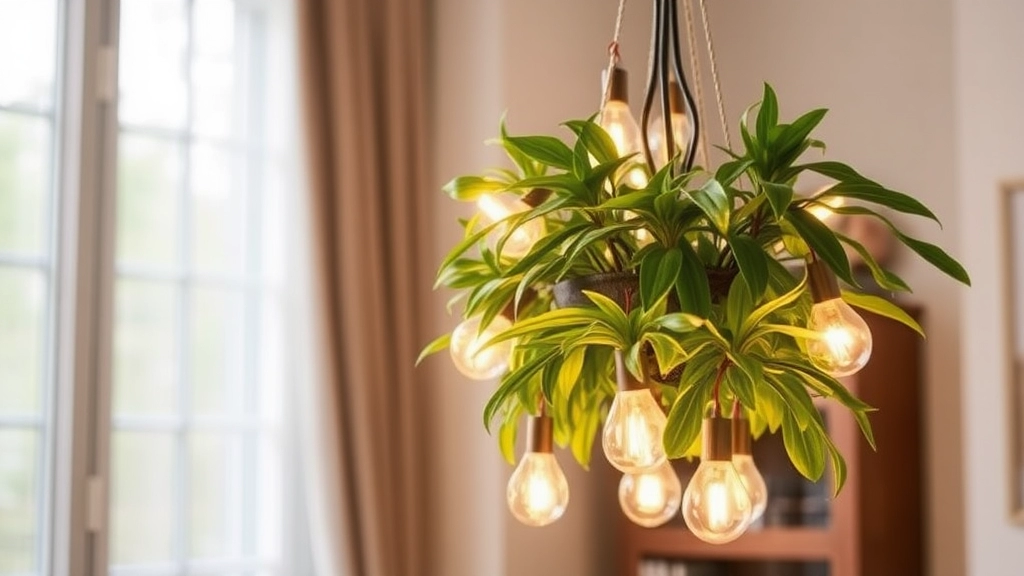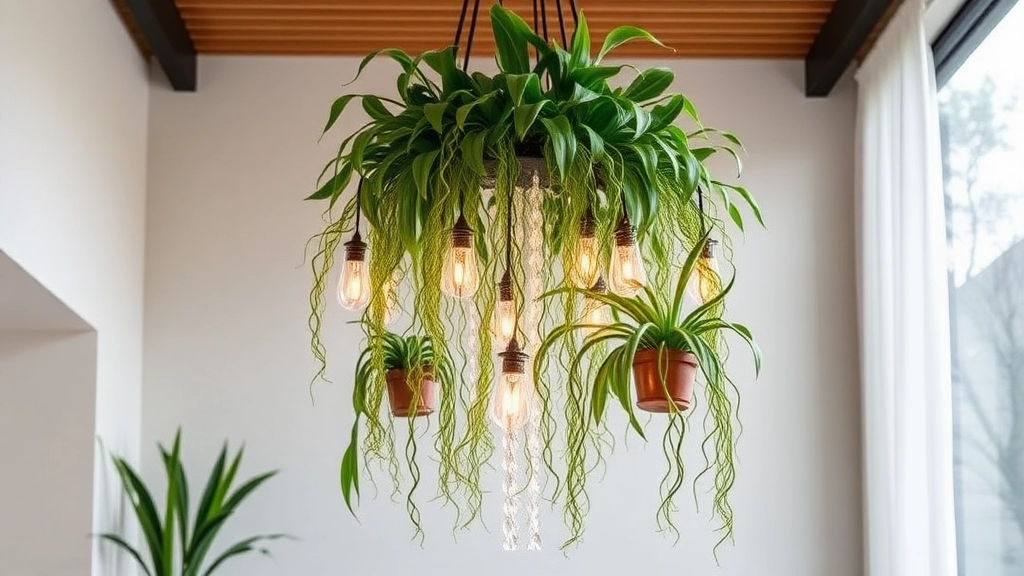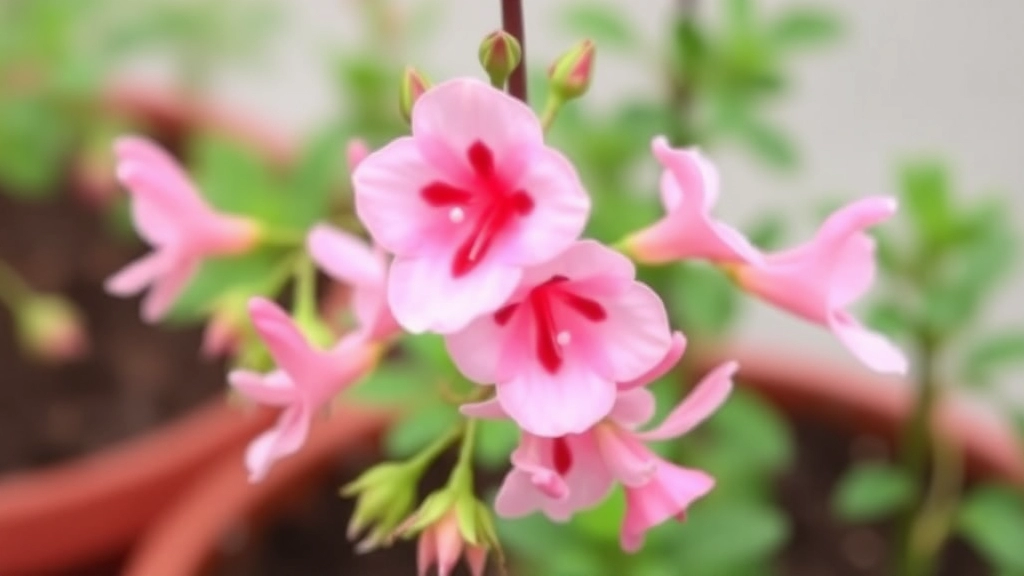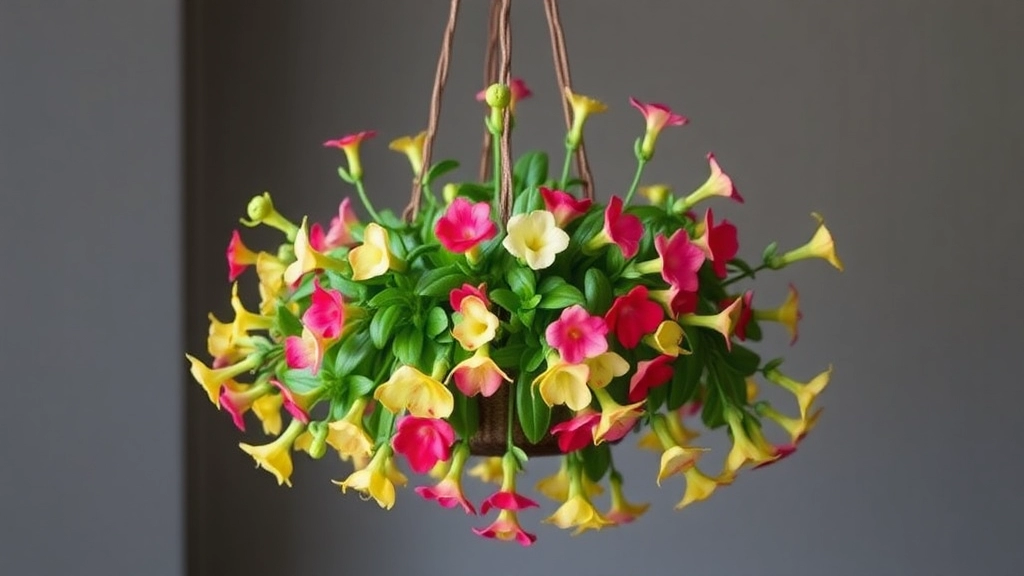Caring for Your Chandelier Plant Kalanchoe
When it comes to caring for your Chandelier Plant Kalanchoe, it’s essential to keep things simple and effective. This unique succulent thrives with minimal fuss, making it a perfect addition to any indoor garden. With the right balance of light, water, and soil, your Kalanchoe can flourish beautifully.
Common Issues
One common issue with the Chandelier Plant is overwatering, which can lead to root rot. To avoid this, ensure your plant is in well-draining soil and water it only when the soil is completely dry.
Propagation
Propagation is also straightforward; simply take a leaf cutting and let it dry out before planting. This easy-to-grow plant not only adds a touch of greenery to your space but also requires minimal maintenance.
Care and Maintenance of Chandelier Plant Kalanchoe
Are you wondering how to keep your Chandelier Plant Kalanchoe thriving?
Caring for this stunning succulent requires a little know-how, but it’s definitely manageable.
Common Issues and Solutions for Chandelier Plant

So, you’ve got your lovely Chandelier Plant (Kalanchoe) and you’re wondering why it’s not thriving like you hoped? Don’t worry; you’re not alone. Many plant lovers face a few hiccups along the way. Let’s dive into some common issues and how to tackle them.
1. Dropping Leaves
What’s Happening?
If your Chandelier Plant is shedding leaves, it might be a sign of stress. This often happens due to overwatering or underwatering.
Solution:
- Check the soil moisture. If it’s soggy, hold off on watering for a bit.
- If the soil is dry, give it a good drink, ensuring it drains well.
2. Leggy Growth
What’s Happening?
If your plant looks like it’s stretching for the sun, it’s likely not getting enough light.
Solution:
- Move it to a brighter spot. Kalanchoe loves bright, indirect sunlight.
- Rotate the plant occasionally to encourage even growth.
3. Pests
What’s Happening?
Tiny critters like mealybugs or aphids can invade your plant, leading to wilting or discoloration.
Solution:
- Inspect your plant regularly. If you spot pests, wipe them off with a damp cloth.
- For a bigger infestation, consider using insecticidal soap or neem oil.
4. Discoloration
What’s Happening?
Yellowing leaves can be a sign of nutrient deficiencies or overwatering.
Solution:
- Check your watering habits. Adjust as necessary.
- Consider feeding your plant with a balanced fertiliser during the growing season.
5. Flower Drop
What’s Happening?
If your plant is dropping flowers prematurely, it could be due to temperature fluctuations or stress.
Solution:
- Keep your plant in a stable environment, avoiding drafts and sudden temperature changes.
- Ensure it’s not too crowded with other plants.
Propagation Techniques for Kalanchoe
When it comes to expanding your collection of Chandelier Plants, Kalanchoe propagation is both rewarding and straightforward. Many plant enthusiasts often wonder how to effectively propagate these vibrant succulents.
1. Leaf Cuttings
This method is one of the most popular for Kalanchoe propagation. Here’s how to do it:
- Select Healthy Leaves: Choose mature, healthy leaves from the parent plant.
- Cut and Dry: Using a clean, sharp knife, cut the leaves at the base. Allow them to dry for a few days until the cut end forms a callus.
- Planting: Place the callused end in well-draining soil, ensuring it is upright.
- Watering: Lightly mist the soil, keeping it slightly moist but not soggy.
2. Stem Cuttings
Another effective method is using stem cuttings, which can produce new plants quickly.
- Choose a Stem: Look for a healthy stem with multiple leaves.
- Cut and Dry: Cut a few inches from the stem and let it dry for a couple of days.
- Planting: Insert the cut end into the soil, burying it about an inch deep.
- Watering: Water sparingly until roots develop.
3. Offsets
Kalanchoe plants often produce offsets, or small pups, that can be removed and replanted.
- Identify Offsets: Look for small plants growing at the base of the parent plant.
- Remove Carefully: Gently twist or cut the offset from the parent, ensuring some roots are attached.
- Planting: Place the offset in its own pot with well-draining soil.
- Watering: Water lightly until established.
4. Seed Propagation
While less common, propagating Kalanchoe from seeds is also possible.
- Seed Collection: Gather seeds from mature flowers once they have dried.
- Sowing: Sprinkle seeds on the surface of moist soil.
- Covering: Lightly cover with soil or vermiculite.
- Watering: Keep the soil consistently moist until germination.
By employing these techniques, you can easily expand your Kalanchoe collection and enjoy the beauty of these unique plants in various settings. For more detailed care tips, check out our expert guide on caring for Kalanchoe succulents and discover the top Kalanchoe succulent varieties that you can add to your garden.
Unique Features of the Chandelier Plant

When considering the Chandelier Plant Kalanchoe, many may wonder what sets it apart from other houseplants.
Distinctive Characteristics:
- Stunning Appearance: The Chandelier Plant is renowned for its cascading, tubular flowers that resemble a chandelier. This unique floral structure adds a touch of elegance to any space.
- Varied Leaf Shapes: The leaves of the Kalanchoe can vary greatly, ranging from rounded to elongated. This diversity enhances its visual appeal and allows for creative arrangements in your home.
- Succulent Nature: As a succulent, the Chandelier Plant stores water in its leaves, making it drought-tolerant. This feature makes it an excellent choice for those who may occasionally forget to water their plants.
- Long Blooming Period: One of the most captivating aspects of the Chandelier Plant is its long flowering season. With proper care, it can bloom for several months, providing continuous colour and interest.
- Air Purifying Qualities: Like many houseplants, the Chandelier Plant contributes to improved indoor air quality by filtering toxins, making it not just beautiful but also beneficial.
Best Soil and Light Conditions for Growth
When nurturing your Chandelier Plant Kalanchoe, understanding the ideal soil and light conditions is crucial for its thriving growth. Many plant enthusiasts often wonder what the best environment is for this beautiful succulent.
Soil Requirements
Kalanchoe prefers well-draining soil to prevent root rot. Here are some key points to consider:
- Cactus or Succulent Soil Mix: Using a pre-made cactus or succulent mix is highly recommended.
- DIY Mix: If you prefer a homemade blend, combine potting soil with sand and perlite in equal parts. This ensures proper drainage.
- pH Level: Aim for a slightly acidic to neutral pH, around 6.0 to 7.0.
Light Conditions
Light plays a pivotal role in the health of your Chandelier Plant.
- Bright, Indirect Sunlight: Kalanchoe thrives in bright, indirect light. A south or west-facing window is ideal.
- Avoid Direct Sun: While it enjoys light, direct sunlight can scorch its leaves.
- Supplemental Lighting: If natural light is limited, consider using grow lights for about 12-14 hours a day.
For more detailed care tips, you can visit our Chandelier Plant Kalanchoe care guide or explore our complete care guide for Kalanchoe Beharensis.
Watering and Fertilizing Guidelines for Chandelier Plant Kalanchoe

So, you’ve got your stunning Chandelier Plant Kalanchoe, and now you’re probably wondering how to keep it thriving.
Watering Tips:
- Drench and Dry: Kalanchoes prefer a good soak, but they hate sitting in water. Water thoroughly until it drains out of the bottom. Then, let the soil dry out completely before the next watering.
- Check the Soil: Stick your finger about an inch into the soil. If it feels dry, it’s time to water. If it’s still moist, hold off.
- Seasonal Changes: In the growing season (spring and summer), you might need to water more often. In winter, cut back on watering since the plant is dormant.
Fertilizing Tips:
- Frequency: Feed your Kalanchoe with a balanced, water-soluble fertilizer every 4-6 weeks during the growing season.
- Dilution: Always dilute the fertilizer to half the recommended strength. Kalanchoes are not heavy feeders, and too much can burn their roots.
- Type of Fertilizer: Look for a fertilizer with a balanced ratio, like 10-10-10 or 20-20-20.
Signs of Overwatering or Underwatering:
- Overwatering: Yellowing leaves and mushy stems can signal too much water.
- Underwatering: If the leaves are shrivelling or looking wrinkled, it’s time to give your plant a drink.
As we explore the fascinating world of Chandelier Plant Kalanchoe, it’s essential to recognize the diverse varieties and hybrids available. This knowledge not only enriches our understanding but also helps in selecting the perfect plant for your space.
### Popular Varieties of Kalanchoe
– **Kalanchoe luciae**
Known for its stunning, paddle-shaped leaves with a vibrant red edge.
Ideal for adding a pop of color to any indoor setting.
– **Kalanchoe tomentosa**
Often referred to as “Panda Plant,” it features fuzzy, grey-green leaves.
A great choice for those who appreciate a unique texture.
– **Kalanchoe blossfeldiana**
This variety is famous for its bright, clustered flowers.
Perfect for those looking to introduce a burst of color.
– **Kalanchoe fedtschenkoi**
Recognized for its trailing habit and beautifully scalloped leaves.
Excellent for hanging baskets or as a cascading feature.
### Notable Hybrids
– **Kalanchoe ‘Calandiva’**
A hybrid known for its double-flowered blooms.
Offers a fuller, more lush appearance compared to traditional varieties.
– **Kalanchoe ‘Pink Butterflies’**
Features delicate pink flowers that resemble butterflies.
Ideal for adding a whimsical touch to your plant collection.
### Choosing the Right Variety
When selecting a Kalanchoe variety, consider the following:
– **Light Requirements**: Some varieties thrive in bright light, while others prefer indirect sunlight.
– **Space**: Trailing varieties are perfect for hanging pots, while upright varieties suit table displays.
– **Aesthetic Preferences**: Choose based on flower color and leaf shape that resonates with your style. For more detailed care instructions, you might find the [complete care guide for Kalanchoe blossfeldiana](https://planthq.org/complete-care-guide-for-kalanchoe-blossfeldiana-succulent/) helpful. Additionally, if you are interested in unique varieties, check out the [types of Kalanchoe tomentosa](https://planthq.org/types-of-kalanchoe-tomentosa-varieties-and-care-tips/).
FAQs about Chandelier Plant Kalanchoe
What are the common issues faced by Chandelier Plant (Kalanchoe) owners?
Common issues include dropping leaves, leggy growth, pest infestations, leaf discoloration, and premature flower drop. Each problem usually has a specific cause and solution.
Why is my Chandelier Plant dropping leaves?
Dropping leaves can be a sign of stress, often due to overwatering or underwatering. Check the soil moisture and adjust your watering habits accordingly.
How can I fix leggy growth in my Chandelier Plant?
Leggy growth is usually a result of insufficient light. Move your plant to a brighter spot with indirect sunlight and rotate it occasionally to ensure even growth.
What should I do if my Chandelier Plant has pests?
Inspect your plant regularly for tiny critters like mealybugs or aphids. Wipe them off with a damp cloth or use insecticidal soap or neem oil for larger infestations.
How do I address leaf discoloration in my Chandelier Plant?
Yellowing leaves can indicate nutrient deficiencies or overwatering. Adjust your watering habits and consider feeding your plant with a balanced fertilizer during the growing season.
Why is my Chandelier Plant dropping flowers prematurely?
Premature flower drop can be caused by temperature fluctuations or stress. Keep your plant in a stable environment, avoiding drafts and sudden temperature changes, and ensure it’s not overcrowded.
What makes the Chandelier Plant unique?
The Chandelier Plant is known for its cascading, tubular flowers, varied leaf shapes, succulent nature, long blooming period, and air-purifying qualities.
How should I water my Chandelier Plant Kalanchoe?
Water thoroughly until it drains out of the bottom and let the soil dry out completely before the next watering. Adjust watering frequency based on the season.
How often should I fertilize my Chandelier Plant?
Feed your Kalanchoe with a balanced, water-soluble fertilizer every 4-6 weeks during the growing season, diluting it to half the recommended strength.
What are the signs of overwatering or underwatering?
Overwatering can cause yellowing leaves and mushy stems, while underwatering can lead to shriveled or wrinkled leaves.
References
-
Kalanchoe Care Guide – The Spruce
-
Kalanchoe Plant Care – Gardening Know How
-
Kalanchoe Plant – House Plants Expert
